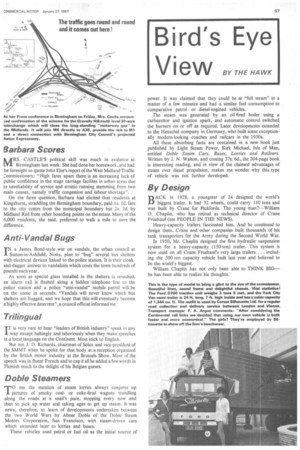Bird's Eye
Page 59

If you've noticed an error in this article please click here to report it so we can fix it.
view BY THE HAWK
At her Press conference in Birmingham on Friday, Mrs. Castle announced confirmation of the scheme for the Gravelly Hill multi-level 30-acre interchange which will close the long-standing "motorway gap" in the Midlands. It will join M6 directly to AU, provide the link to M1 and a direct connection with Birmingham City Council's projected Aston Expressway.
Barbara Scores
MRS. CASTLE'S political skill was much in evidence at Birmingham last week. She had done her homework, and had he foresight to quote John Else's report of the West Midland Traffic 2.ommissioners: "High fares apart there is an increasing lack of public confidence in the stage carriage facilites in urban areas due to unreliability of service and erratic running stemming from two main causes, namely traffic congestion and labour shortage".
On the fares question, Barbara had elicited that residents at Kingshurst, straddling the Birmingham boundary, paid ls. Id. fare to the city centre from the municipal boundary but 2s. 2d. by Midland Red from other boarding points on the estate. Many of the 6,000 residents, she said, preferred to walk a mile to save the difference.
Anti-Vandal Bugs
TN a James Bond-style war on vandals, the urban council at 1 Sutton-in-Ashfield, Notts, plan to "bug" several bus shelters with electrical devices linked to the police station. It is their cloakand-dagger answer to vandalism which costs the town hundreds of pounds each year.
As soon as special glass installed in the shelters is smashed, an alarm call is flashed along a hidden telephone line to the police station and a police "anti-vandal" mobile patrol will be on the scene in seconds. "Vandals will never know which bus shelters are bugged, and we hope that this will eventually become a highly effective deterrent", a council official informed me.
Trilingual
TT is very rare to hear "leaders of British industry" speak in any 1 way except haltingly and laboriously when they make speeches in a local)anguage on the Continent. Most stick to English.
But not J. D. Richards, chairman of Solex and vice-president of the SMMT when he spoke for that body at a reception organized by the British motor industry at the Brussels Show. Most of the speech was in fluent French and to cap it all he added a few words in Flemish much to the delight of his Belgian guests.
Doble Steamers
T0 me the mention of steam lorries always conjures up pictures of smoky coalor coke-fired wagons trundling along the roads at a snail's pace, stopping every now and then to pick up water and taking ages to get up steam. It was news, therefore, to learn of developments undertaken between the two World Wars by Abner Doble of the noble Steam Motors Corporation, San Francisco, with steam-driven cars which extended later to lorries and buses.
These vehicles used petrol or fuel oil as the initial source of power. It was claimed that they could be at "full steam" in a matter of a few minutes and had a similar fuel consumption to comparative petrolor diesel-engined vehicles.
The steam was generated by an oil-fired boiler using a carburettor and ignition spark, and automatic control switched the burners on or off as required. Later developments extended to the Henschel company in Germany, who built some exceptionally modern-looking coaches and railcars in the 1930s.
All these absorbing facts are contained in a new book just published by Light Steam Power, Kirk Michael, Isle of Man, entitled Doble Steam Cars, Buses, Lorries and Railcars. Written by J. N. Walton, and costing 37s. 6d., the 204-page book is interesting reading, and in view of the claimed advantages of steam over diesel propulsion, makes me wonder why this type of vehicle was not further developed.
By Design
BACK in 1928, a youngster of 24 designed the world's biggest trailer. It had 32 wheels, could carry 110 tons and was built by Crane for Pickfords. The young man?—William D. Chaplin, who has retired as technical director of Crane Fruehauf (see PEOPLE IN THE NEWS).
Heavy-capacity trailers fascinated him. And he continued to design them. Crane and other companies built thousands of his tank transporters for the Army during the Second World War.
In 1950, Mr. Chaplin designed the first hydraulic suspension system for a heavy-capacity (150-ton) trailer. This system is now used on all Crane Fruehauf's very large trailers . . . including the 300 ton capacity vehicle built last year and believed to be the world's biggest.
William Chaplin has not only been able to THINK BIG— he has been able to realize his thoughts.












































































































